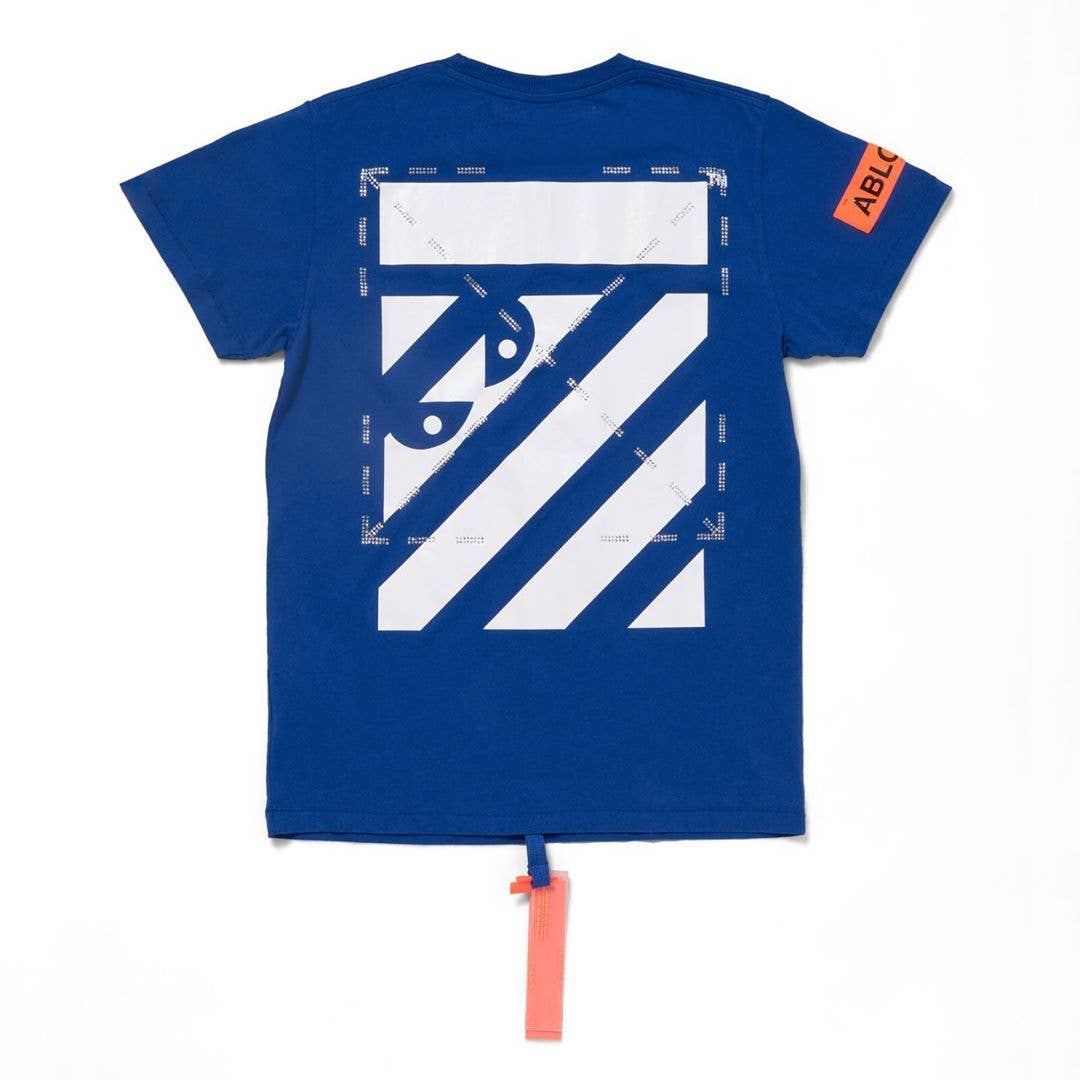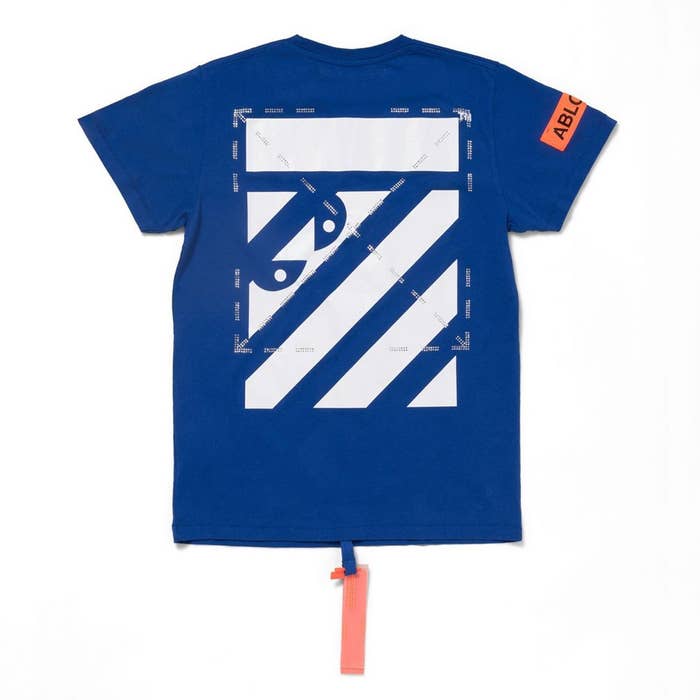
Last summer, a London-based graphic designer named Simon Brown received an email from the Museum of Contemporary Art in Chicago and book publisher Prestel. He thought it read more like spam from a suspicious dating site. It stated, “I've got this client called Virgil, we're making a book for him. We would like to meet you." Brown said it reminded him of an email he received years ago when he was contacted to make a book for the architect Rem Koolhaas. A straight forward request, from a highly influential figure, that was very played down.
“It wasn't like ‘You need to come and do this and you can't tell anyone.’ It was like, ‘Just come and meet us,’” Brown says. “It wasn't until I sat in the offices of Louis Vuitton that I realized that this was actually quite serious,” Brown says. “Virgil was actually Virgil Abloh.”
For nearly two decades, the 42-year-old Brown has led &&&, a graphic design agency that’s worked on projects for magazines like Reader’s Digest and cellphone companies like Vodafone rather than the creative director of Louis Vuitton.
Unbeknownst to Brown, Koolhaas was one of Virgil's heroes and when they met the Off-White designer pulled out the book, titled Content, that Brown designed for the architect 15 years ago. Virgil told Brown that it was a source of inspiration.
After serving as a design consultant for the book that accompanies Abloh’s “Figures of Speech” exhibition at the MCA Chicago, Brown’s work with Abloh has snowballed into an official Off-White collaboration currently being sold through MCA. The collaboration has Brown bringing life to Abloh’s work over the years. Static objects like a building Abloh designed for his master’s thesis and an IKEA “Keep Off” rug, are redrawn by Brown as emotive characters.
“Virgil was super kind to drop the collab and point it towards me, which is another amazing example of how Virgil works. It is a true collaboration,” Brown says. “Since its release, more people contacted me than ever before on Instagram. Some of the messages are quite simple and straightforward. "This is sick,” “This is dope,” or “I really love it." Others are a little bit more detailed like, "I'm a young designer. How could I go about doing something like this?"
We phoned Brown to learn about his background, working on the exhibition book for “Figures of Speech,” his experience collaborating with Virgil Abloh, and more details on ‘Our Label,’ his upcoming clothing line under &&&.
(This interview has been edited and condensed for clarity.)
How did you meet Virgil Abloh? I see that you were credited as one of the three creative agencies that helped produce the “Figures of Speech” book.
So last year I was contacted by the MCA and Prestel who published the “Figures of Speech” book. I didn’t know this at the time, but one book that inspired Virgil throughout his career was Content. That was the book &&& designed for Rem Koolhaas.
Virgil's idea was that he wanted to build a dream team of designers. Comprised of multiple agencies and people who could come together to produce a book that covered the breadth of who he was as an individual as well as his work.
So the team he set up, which is credited in the book as a "dream team," were the creative agencies &&&, Playlab, and OK-RM. Towards the end of producing the book, it was quite clear that everyone had their own niche aspects. We all brought different aspects to the book from graphic design, design consulting, to just managing and organizing the amount of content that was available.
From my role as a design consultant for the whole project, I spent a lot of time with Virgil and that naturally went on to working on this collaboration together.
What’s the background of your graphic design agency, &&&?
I started &&& in 2001 and have been running it for nearly 20 years. It was off the back of working, producing and art directing men's magazines when I was contacted by Benedikt Taschen and the architect Rem Koolhaas. They asked if I could produce a publication for them which would challenge the way architecture would be seen and also capture seven years of Rem Koolhaas's work.
So, that’s what kick started &&& as a design agency. From there we went on to work with other art institutions like the Serpentine Galleries in London and the ICA [Institute of Contemporary Art] in Boston. We have also worked with larger commercial clients like Vodafone.
I've kind of led the whole of &&&, whether it be 10 people or two people, and then worked with and collaborated with lots of different people over the years. The latest collaboration obviously being with Virgil Abloh.
What art has inspired you over the years?
There's stuff that really inspired me when I was young. The optical art movement and the Barbara Hepworth kind of look at the world. That really opened my mind when I was a youngster. And then obviously someone like Peter Saville. As a young graphic designer you look up to these people and continue to look at their work in awe.
But the more that I traveled through &&&, I met obscure designers that you wouldn't have heard of and realized that seeing design work from these designers is just truly inspirational. Seeing people do typefaces out of brown paper, for instance. That’s the best bit of inspiration for me.
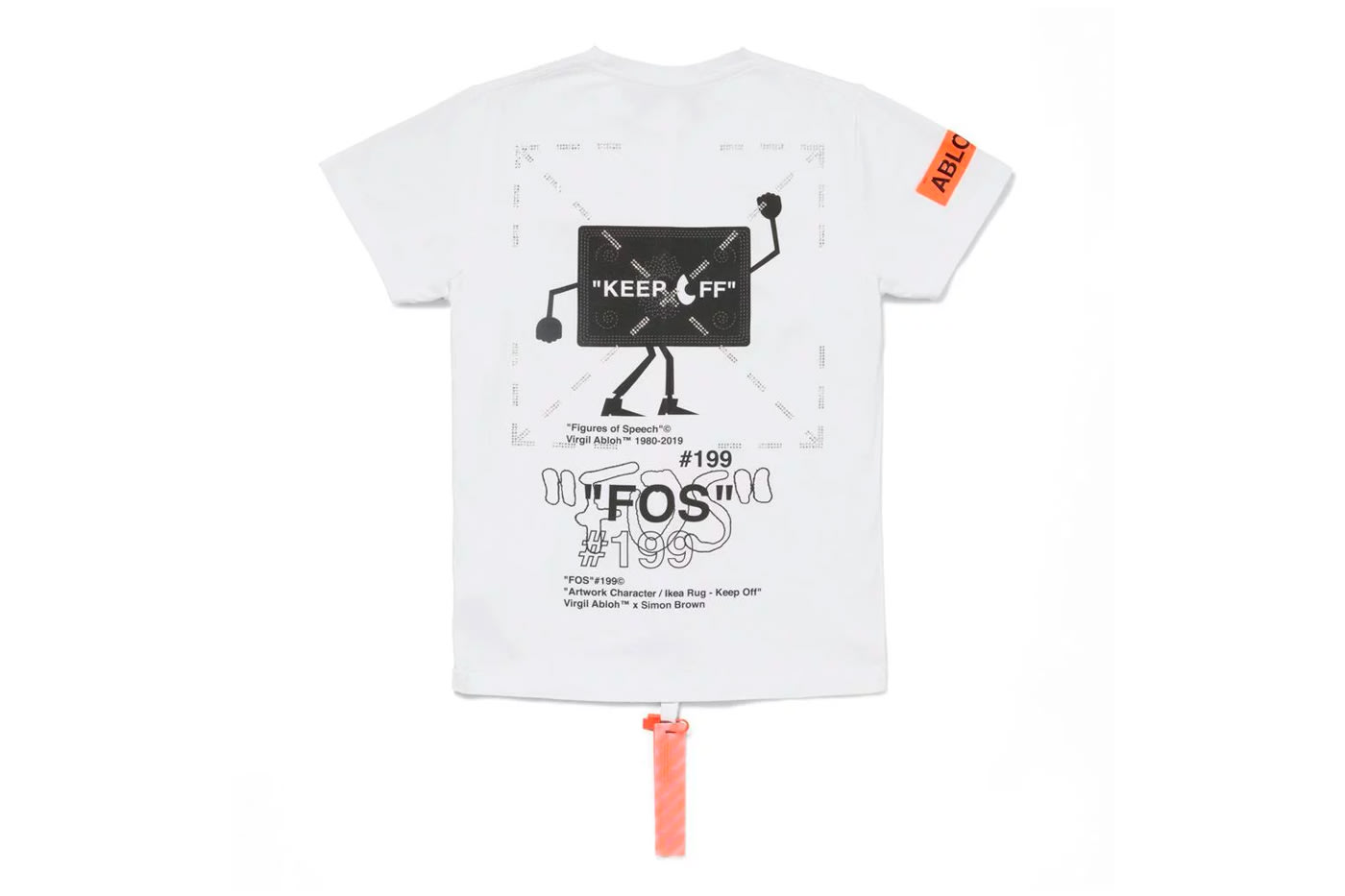
The recent Off-White collaboration seemed heavily inspired by the art you made in Content. Especially how you turned Koolhaas’ architecture into characters.
So if you look at the Off-White collaboration, I turn Virgil’s logos into characters on the back of his garments. That's a staple production of &&&. It’s making a character out of things that are really recognizable and giving that character a persona. One shirt in that collaboration with Virgil, features his IKEA “Keep Off” rug as a character with his arms up shouting “Keep Off! Keep off the rug.”
So, all the pieces captured the persona of what the original idea was. When I was making those shirts with Virgil I was given a rough silhouette or image. But the discussion we were having about what that collaboration was: Were these images ever completed? What's the feeling or emotion of it? So we developed it off that.
Did you ever meet Virgil before he reached out to you?
No, never.
When you met him was it like a job interview?
No, we were just all in the Louis Vuitton office and it was this brilliant meeting of minds. That book was designed by myself and John Link. I also introduced Abloh to John, and he got involved in some other ideas in the book. So if you look in the back of “Figures of Speech,” you’ll see John Link credited in the back of there as well. It was just a really exciting time.
Did he detail what parts of Content he was inspired by specifically?
I think it's an overarching idea that you could be anything if you really want it. And also challenging the conventions of the norm in a positive way. If you look at Rem Koolhaas’ book before Content, an extraordinary work by Bruce Mau titled S,M,L,XL. It is a big monolithic book about architecture. It was not a magazine/book hybrid that can challenge and also look at culture, life, and community while bringing that back to architecture.
So I think what inspired Virgil about the book itself was the fact that you could be anything. An average Joe or someone who just had an inspiration to be an architect could actually be an architect. Obviously Content doesn’t look like “Figures of Speech.” But I think the background behind it is the more interesting thing—what it stood for and how that inspired people.
So how many people were actually on the book team for “Figures of Speech”?
Including myself and employees from OK-RM, Playlab and Prestel, it was a big team of people. Not everyone is working on it all of the time, and some bits are quite niche, but I still think it's a big team. It was quite a feat and I think the most interesting thing about the whole project is seeing this kind of change in culture. Virgil being at Louis Vuitton is mesmerizing and inspiring at the same time. What I think is extraordinary about the book and the exhibition is that Virgil pulled off getting a set of people together who would never be in the same room together. To actually collaborate and bring their best bits together. Unless you read that front bit in the book you would never understand how he did that. It's extraordinary and it was an honor to be apart of that and see it work.
What was the direction that Virgil gave to the team behind the book’s production?
A lot of it was asking, ‘What is the book? What is the narrative and the discussion for it?’ Playlab and OK-RM worked an awful lot on that kind of description. A lot of it was also lead by Samir Bantal from the Office for Metropolitan Architecture (OMA) who designed the exhibition. They helped develop the narrative of the whole show at the exhibition.
You could actually see that narrative on one of the green “Figures of Speech” tees released at MCA. On the back of that T-shirt is a narrative diagram that shows how all of the pieces of work transcend from being.
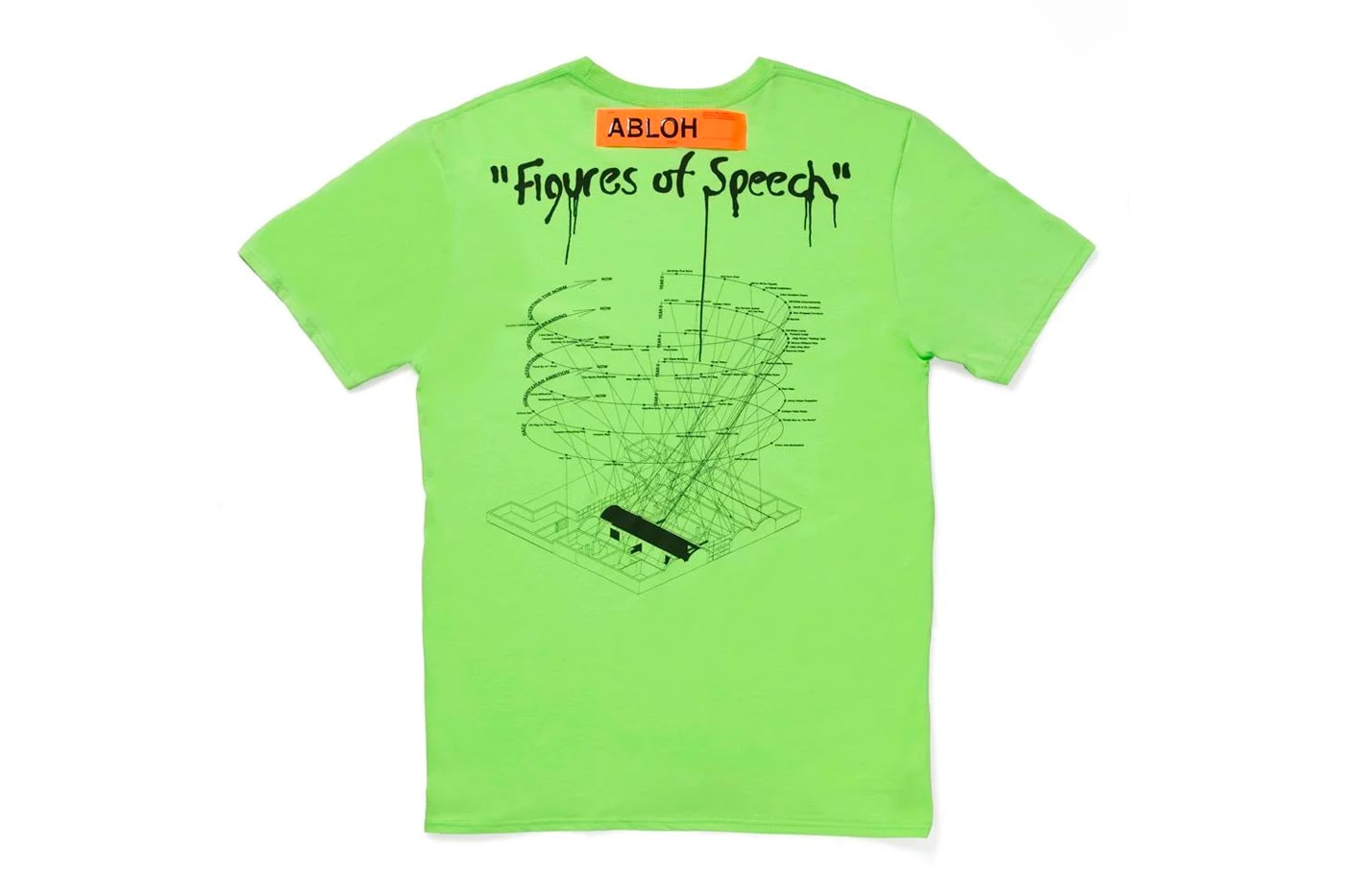
What were the biggest challenges when it came to making the “Figures of Speech” book?
I think the biggest challenge is getting companies to sit together in the room. If you work collaboratively, the best thing is knowing the bits that you're good at and what you're going to bring to the party; while also accepting the fact that there's going to be other people in the room with just as brilliant ideas, if not better ideas than yourself, and then running with those. I think you had a team of people that were willing to do that. I think there was this group ethos of believing in that collaborative spirit.
Tell me more about your role as a design consultant. You said you spent a lot of time with Virgil throughout the whole process of making this book?
My phone on WhatsApp has never been so hot. I mean, a daily consultation of making stuff quickly. Daily inspiration via WhatsApp. It didn't matter what day or time it was. It was just 24 hours of open discussion with Virgil. We were constantly sharing creative ideas, layouts, things that you find of inspiration. It was like this daily inspiration of sharing stuff that would trigger further ideas. It was a constant two-way dialogue.
What did you learn from working with Virgil?
I learned that being open-minded and never saying no is a great thing. It reinforced another idea that I'd almost forgotten from Rem Koolhaas, which is to always be prepared to invite yourself to unexpected places.
The other thing that I learned is that if you're keen, hungry to work and produce something, then the world's your oyster if you collaborate with someone like Virgil. It's quite rare to get an opportunity where someone in that position will have discussions, minute by minute with you on a daily basis.
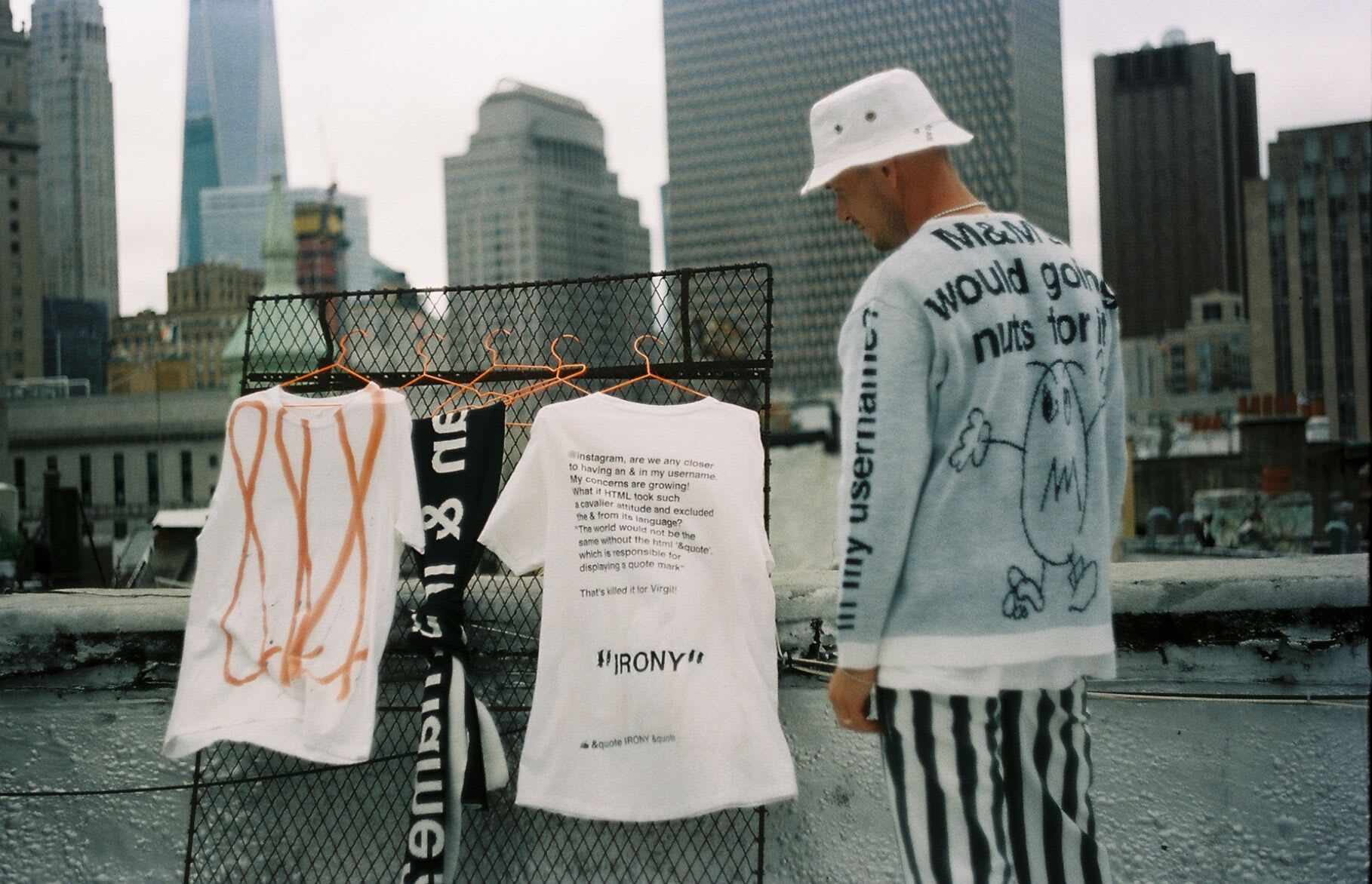
How did this experience with Virgil inspire you to make your own clothing?
So the “&” is like a thing that means so many different things. It means a connection between me and you. It means collaboration. It also means the future's never ending. So, as a design consultant it makes sense that I actually go out to promote that. To actually turn that kind of brand and ethos into something that is wearable.
This whole experience working with Virgill and producing clothing with him has given me a new vigor for &&& to be a label. My first collection, “Can I have an & in my username?,” is directed at a social media company like Instagram. But what it’s really about is having a discussion about how much we use mobile phones and not having actual conversations.
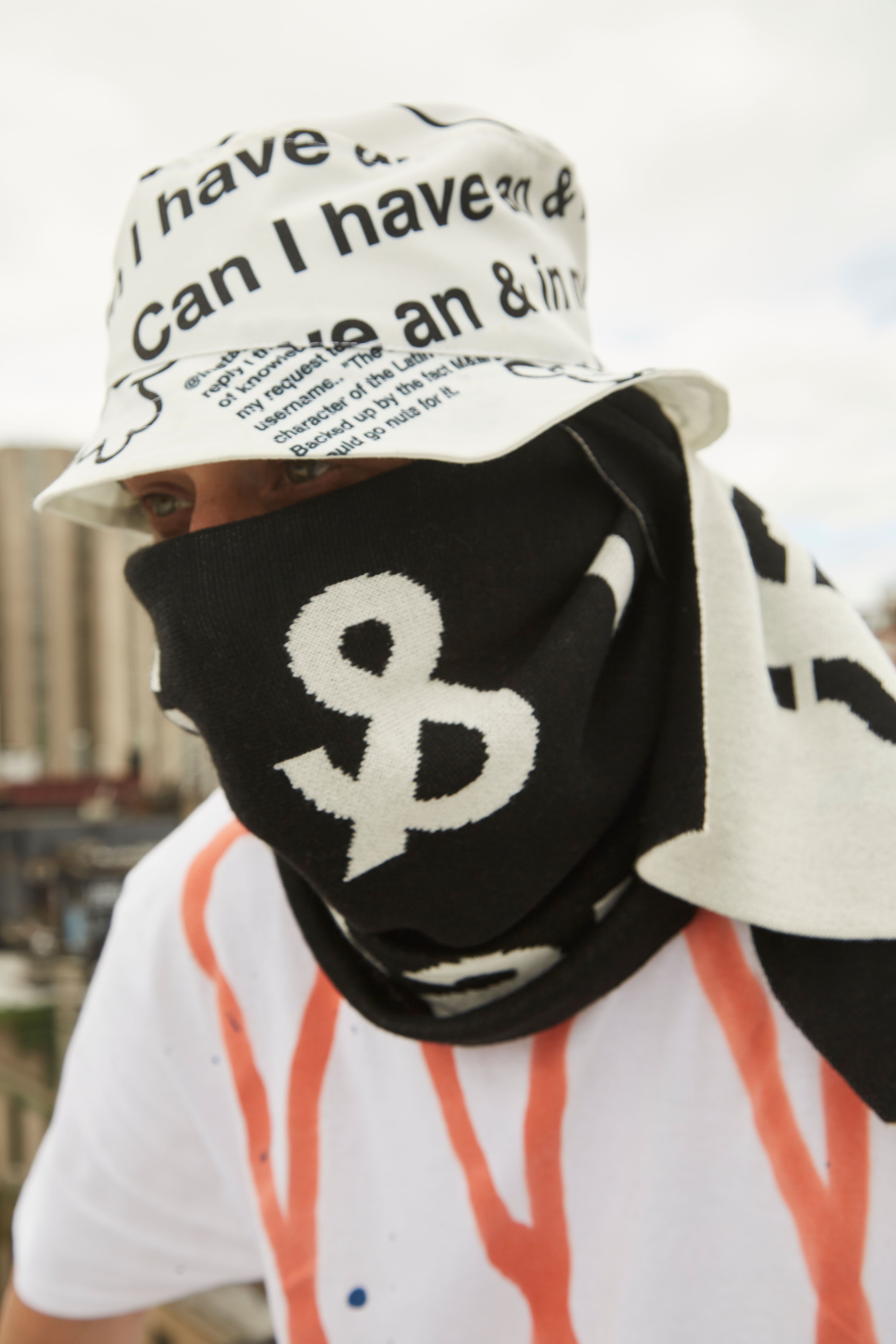
So when did you start exactly making clothes for &&&?
Strangely, we did make some clothes for Content. But it really started as soon as I met Virgil.
I see you rolled out this interesting independent ad campaign where you cut out a life-sized “&” and toted it around major cities.
Yes, I carved one out in Chinatown and then I walked all over New York. I met hundreds of people and then they've become part of a movement, if you want to call it that. I walked into the Metropolitan Museum of Art with it and I had to get a certificate to leave because they thought my big “&” was a piece of contemporary art. I brought the “&” to a meeting with the head of Pentagram, Michael Bierut, and had a discussion about design entrepreneurship. I’ve also delivered the “&” to Instagram’s headquarters in New York and London.
You were also present with it during Paris Fashion Week right?
Yeah, I hosted a street pop up during Paris Fashion Week. When I was in Paris, I also produced these newspapers featuring all of the direct messages that I'd sent to Instagram’s account about adding an “&” to my username. Takashi Murukami’s stylist, Takeshi Ishida of Cherry Fuoka, was actually photographed holding one of those newspapers. Out of the hundreds of messages I sent to Instagram, I turned one message that read “M&M’s would go nuts for it” into a knit sweater.
What should we expect to see &&& release in the near future?
Bucket hats, T-shirts, scarves and jumpers, which are all part of that “Can I have an ‘&’ in my username?” collection that I’m going to drop later this year. It will probably be released at like a streetside shop. It'll be something that's pretty extraordinary.
So, basically this is all independent, right? How does it feel to already have a collaboration with someone like Virgil?
This is all mine. Well, I think even for myself, when I looked at the 'Church & State' shop in the MCA, what’s really extraordinary is not that my T-shirts are in there with Virgil. It's the fact that it’s being sold with items by Futura and Tom Sachs. To be inside that retail shop, inside an exhibition with some of the best people and the best thinkers of our time, it's just extraordinary for me. That's really humbling.
I feel like a lot of young people today would dream about getting this kind of collaboration under their belt. It's impressive how this collaboration came about organically and quickly.
It's super quick, but that doesn't happen overnight. I've recently been talking to a lot of young people through Instagram. I'm open to talk to keen young creatives about how to make it in the industry. I tell them that you actually need to work exceptionally hard. You need to have great ideas. You need to understand what type of thing you want to produce and who you want to communicate that to. The bottom line of everything is how hard you work.


